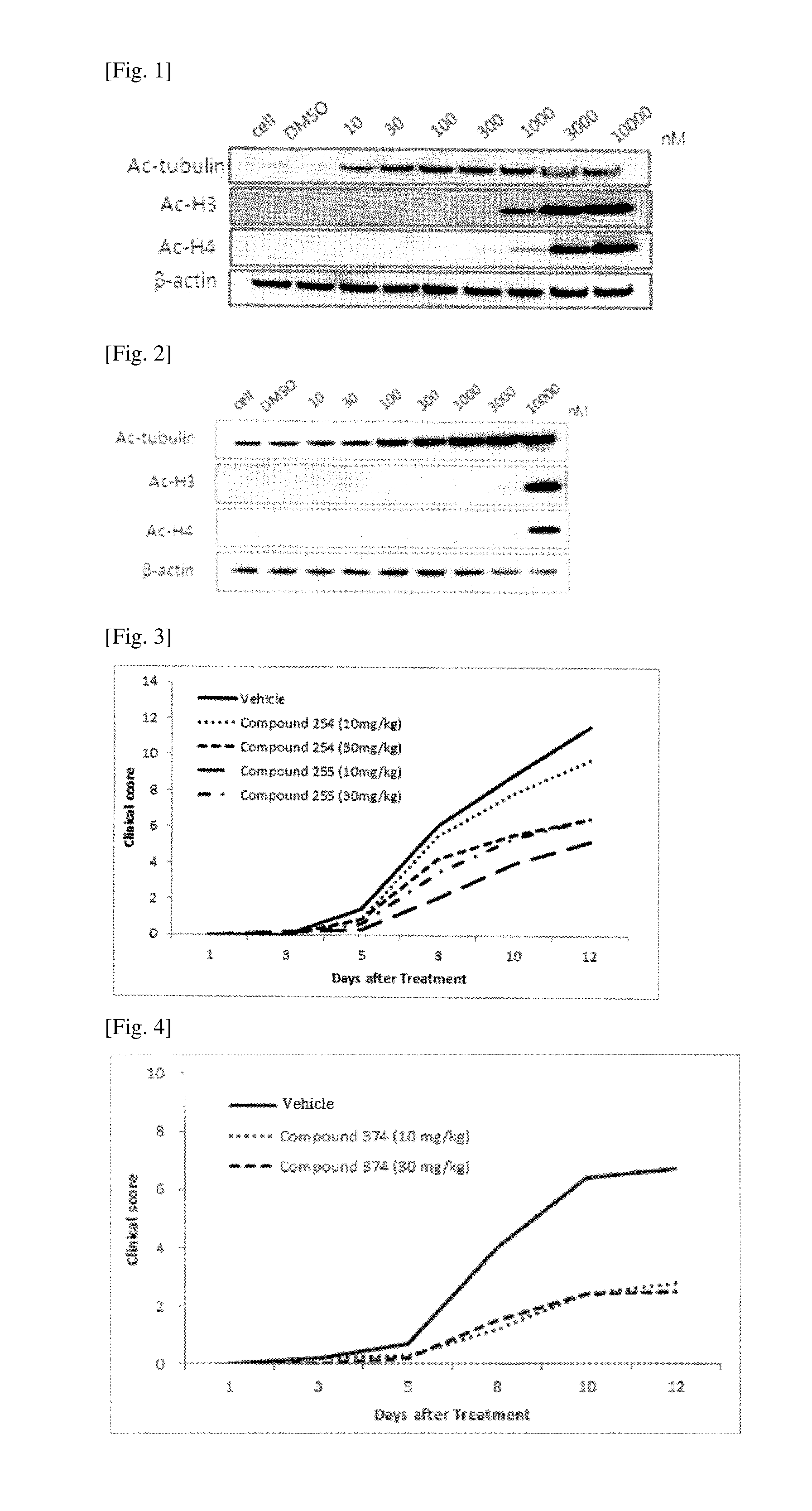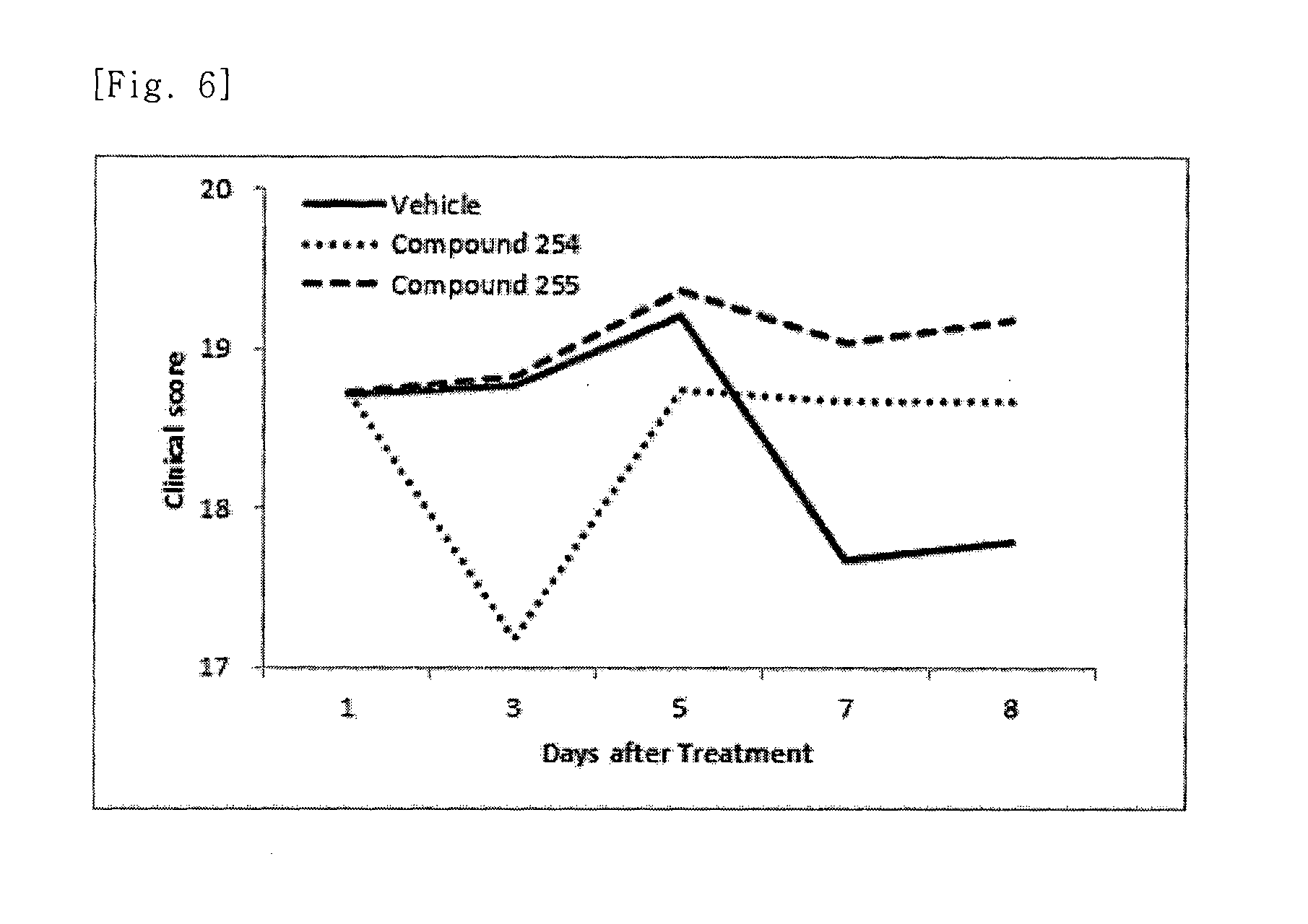Novel compounds for selective histone deacetylase inhibitors, and pharmaceutical composition comprising the same
a technology of histone deacetylase and inhibitors, which is applied in the direction of drug compositions, immunological disorders, metabolism disorders, etc., can solve the problems of hdac inhibitors having and most of the hdac inhibitors have drawbacks in terms of efficacy and side effects
- Summary
- Abstract
- Description
- Claims
- Application Information
AI Technical Summary
Benefits of technology
Problems solved by technology
Method used
Image
Examples
example 1
Synthesis of Compound 252
Formula 1-2
methyl 4-((3-bromophenylamino)methyl)benzoate
[0174]
[0175]Compound of Formula 1-1 (3-bromobenzenamine; 5 g, 29 mmol) was dissolved in dichloromethane (200 mL), and then methyl 4-fomylbenzoate (5.7 g, 35 mmol) and acetic acid (1.74 mL, 29 mmol) were added and stirred for 1 hour. Then, sodium cyanoborohydride (2.2 g, 35 mmol) was slowly added dropwise and stirred for 1 day. Water was poured into the reaction mixture, and the organic layer was extracted. The organic layer was washed with saturated sodium chloride aqueous solution, dehydrated with anhydrous magnesium sulfate, and then concentrated under reduced pressure. The residue was purified and concentrated by column chromatography (silica; ethyl acetate / hexane=20%) to give the desired compound of Formula 1-2 (7.8 g, 84%) in the form of a white solid.
Formula 3-1
methyl 4-(((3-bromophenyl)((4-nitrophenoxy)carbonyl)amino)methyl)benzoate
[0176]
[0177]Compound of Formula 1-2 (methyl 4-((3-bromophenylamin...
example 2
Synthesis of Compound 253
Formula 3-3
methyl 4-((4-methyl-N-(3-(1-methyl-1H-indazol-5-yl)phenyl)piperazine-1-carboxamido)meth yl)benzoate
[0185]
[0186]Compound of Formula 3-2 (methyl 4-(((3-(1-methyl-1H-indazol-5-yl)phenyl)((4-nitrophenoxy)carbonyl)amino)methyl)benzoate; 0.05 g, 0.093 mmol) was dissolved in dimethylformamide (10 mL), and then n-methylpiperazine (0.016 mL, 0.14 mmol) and potassium carbonate (0.039 g, 0.28 mmol) were added. Then, the mixture was heated and stirred at 55° C. for 12 hours. Water was poured into the reaction mixture, and the organic layer was extracted with ethyl acetate. The organic layer was washed with saturated sodium chloride aqueous solution, dehydrated with anhydrous magnesium sulfate, and then concentrated under reduced pressure. The residue was purified and concentrated by column chromatography (silica; methanol / dichloromethane=5%) to give the desired compound of Formula 3-3 (0.044 g, 95%) in the form of a colorless liquid.
Compound 253
N-(4-(hydroxyc...
example 3
Synthesis of Compound 254
Formula 3-2
methyl 4-(((3-(1-methyl-1H-indazol-6-yl)phenyl)((4-nitrophenoxy)carbonyl)amino)methyl)benzoate
[0190]
[0191]Compound of Formula 3-1 (methyl 4-(((3-bromophenyl)((4-nitrophenoxy)carbonyl)amino)methyl)benzoate; 1.00 g, 2.06 mmol), 1-methyl-1H-indazol-6-ylboronic acid (0.435 g, 2.47 mmol), Pd(dppf)Cl2 (0.168 g, 0.206 mmol), and sodium carbonate (0.693 g, 4.53 mmol) were mixed with dimethoxyethane (5 mL) / H2O (5 mL), heated at 120° C. for 15 minutes under microwave irradiation, and then the temperature was lowered to room temperature. Water was poured into the reaction mixture, and the organic layer was extracted with ethyl acetate. The organic layer was washed with saturated sodium chloride aqueous solution, dehydrated with anhydrous magnesium sulfate, and then concentrated under reduced pressure. The residue was purified and concentrated by column chromatography (silica; ethyl acetate / hexane=30%) to give the desired compound of Formula 3-2 (1.03 g, 93%)...
PUM
 Login to View More
Login to View More Abstract
Description
Claims
Application Information
 Login to View More
Login to View More - R&D
- Intellectual Property
- Life Sciences
- Materials
- Tech Scout
- Unparalleled Data Quality
- Higher Quality Content
- 60% Fewer Hallucinations
Browse by: Latest US Patents, China's latest patents, Technical Efficacy Thesaurus, Application Domain, Technology Topic, Popular Technical Reports.
© 2025 PatSnap. All rights reserved.Legal|Privacy policy|Modern Slavery Act Transparency Statement|Sitemap|About US| Contact US: help@patsnap.com



